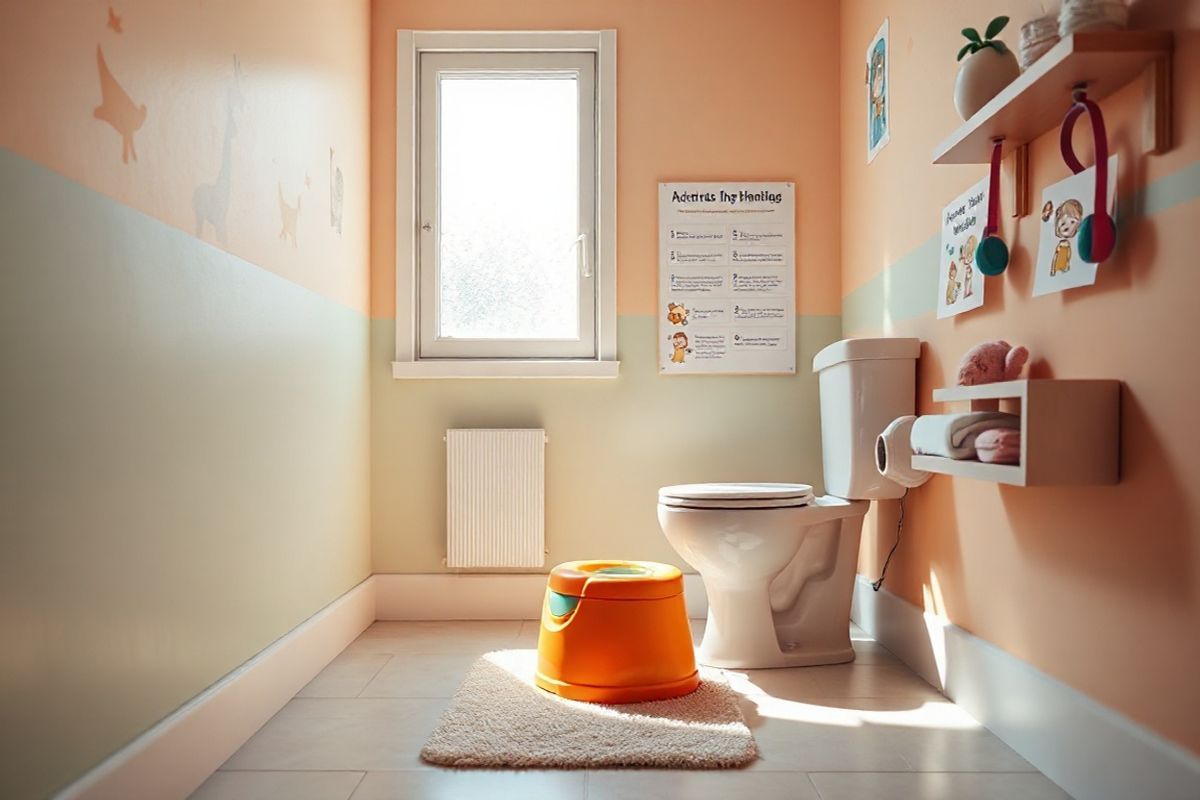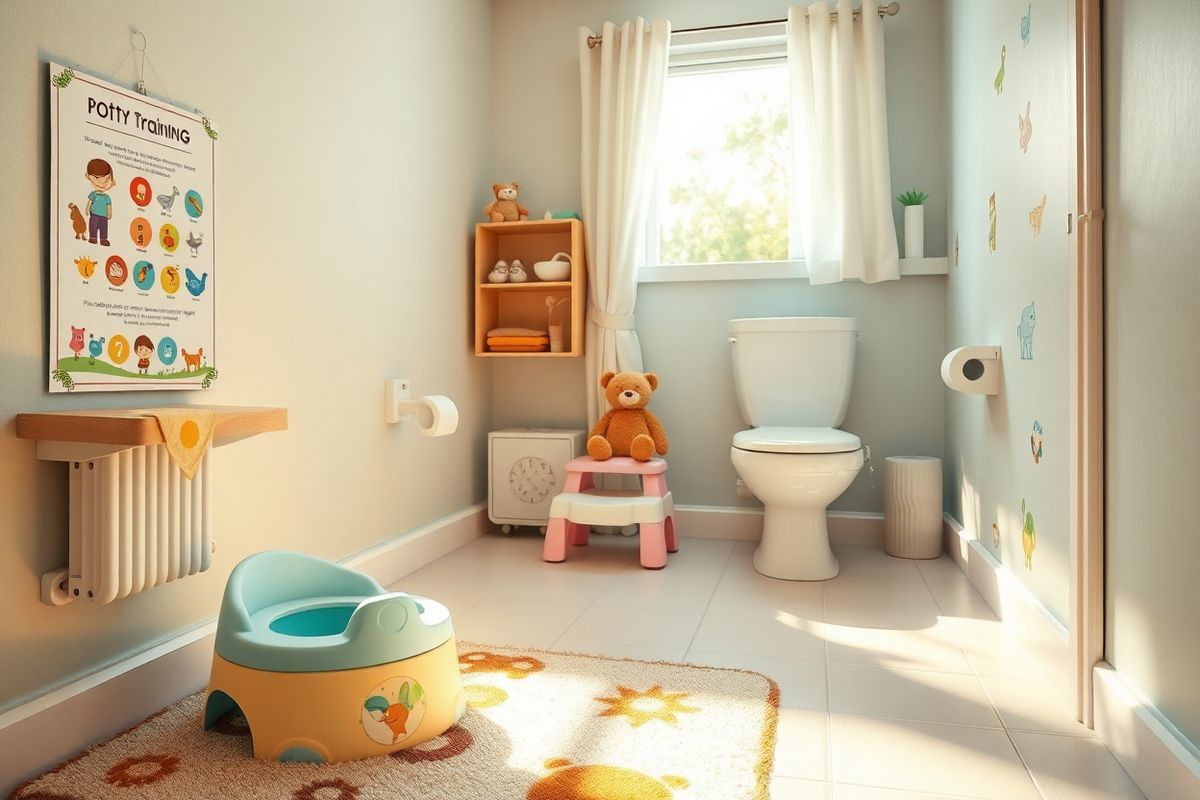Table of Contents
Understanding the Unique Challenges of Potty Training for Autistic Children

Potty training is a significant milestone in a child’s development, marking the transition from diapers to independence. For autistic children, this process can present unique challenges that require tailored strategies and understanding. Autism Spectrum disorder (ASD) is characterized by a range of symptoms that may affect social skills, communication, and behavior, which can complicate the potty training process (CDC, 2023).
Many autistic children may exhibit difficulties with changes in routine, sensory sensitivities, and communication barriers, making traditional potty training methods less effective. For instance, a child may struggle to recognize the physical cues indicating the need to use the toilet, or they might resist changing their routine, which includes transitioning from using diapers to utilizing the toilet (Mayo Clinic, 2023). Additionally, sensory sensitivities may make bathrooms uncomfortable due to noise, lighting, or the feel of toilet seats.
Furthermore, the variability in the presentation of autism means that what works for one child may not work for another. Individual differences in processing sensory information, understanding social cues, and communicating needs necessitate a more personalized approach to potty training (Raising Children, 2023). Understanding these unique challenges sets the foundation for developing effective and empowering potty training strategies for autistic children.
Essential Preparations: Creating a Supportive Environment for Success

Preparation is crucial in establishing a conducive environment for potty training. To begin, parents and caregivers should assess the child’s readiness for potty training. Signs of readiness may include demonstrating discomfort with dirty diapers, showing interest in the bathroom, or communicating the need to go (KidsHealth, 2023). It is essential to wait until the child is genuinely ready, as starting too early can lead to frustration for both the child and the caregiver, prolonging the process.
Creating a supportive environment involves several key strategies:
-
Visual Supports: Many autistic children benefit from visual aids that can help them understand the potty training process. Implementing charts that outline steps for using the toilet, complete with pictures, can provide clear guidance. A visual schedule can also help the child anticipate bathroom breaks, making the process more predictable and less stressful.
-
Accessible Potty Equipment: Ensure that the bathroom is equipped with child-friendly resources, such as a potty chair or seat adapter that fits securely on the regular toilet. This accessibility can enhance the child’s comfort and willingness to use the toilet.
-
Routine Establishment: Establishing a consistent routine is vital. Children thrive on predictability, and incorporating regular bathroom breaks into their daily schedule can reinforce the habit. For example, encouraging bathroom visits after meals or before bedtime can utilize natural body rhythms to prompt the child (Human Society, 2023).
-
Sensory Considerations: Address any sensory sensitivities by making the bathroom a more inviting space. This may include using soft lighting, minimizing noise, or allowing the child to bring a favorite toy for comfort during the process.
By creating a supportive and prepared environment, caregivers can significantly enhance the likelihood of successful potty training for autistic children.
Tailored Techniques: Effective Potty Training Methods for Autistic Kids
Various techniques can be employed to tailor the potty training experience for autistic children, recognizing their unique needs and preferences. Some effective methods include:
-
Positive Reinforcement: Utilizing positive reinforcement is critical in motivating autistic children during potty training. Rewards can range from verbal praise to tangible rewards such as stickers or small toys for successful toilet use. This approach encourages the child to associate the act of using the toilet with positive experiences (Moms on Call, 2023).
-
Social Stories: Social stories are narratives that depict a situation and the appropriate responses to it. Crafting a social story about using the potty can help the child understand what to expect and alleviate anxiety associated with the process. These stories can be read together regularly to reinforce learning and familiarity.
-
Peer Modeling: If possible, arranging for the child to observe peers or siblings using the toilet can provide a powerful learning experience. Children often learn through imitation, and seeing a peer successfully navigate potty training can encourage them to do the same.
-
Gradual Transition: For children who may feel overwhelmed by the sudden change from diapers to using the toilet, a gradual transition can be beneficial. This might involve starting with training pants that resemble underwear but offer some protection, gradually moving towards using the toilet exclusively.
-
Communication Tools: Since many autistic children may struggle with verbal communication, incorporating communication tools such as picture exchange systems or communication apps can help them express their needs related to toilet use. This not only empowers the child but also reduces the likelihood of frustration.
-
Routine and Consistency: As previously mentioned, establishing a consistent routine is essential. Potty training should be approached with patience, recognizing that the process can take time and that accidents are natural. Consistency in approach, language, and rewards will help solidify the learning experience.
By implementing these tailored techniques, caregivers can create a more effective potty training experience that aligns with the child’s individual needs and abilities.
Celebrating Progress: Positive Reinforcement and Motivation Strategies
Celebrating progress during potty training is vital for maintaining motivation and encouraging continued success. Positive reinforcement not only helps to motivate autistic children but also builds their confidence in mastering this new skill. Here are some strategies for effectively celebrating progress:
-
Immediate Praise: Providing immediate praise after the child successfully uses the toilet reinforces the behavior. Verbal affirmations such as “Great job!” or “You did it!” should be accompanied by physical gestures like high-fives or hugs.
-
Reward Systems: Establishing a reward system can further incentivize the child. This might involve a sticker chart where the child earns stickers for each successful bathroom visit, leading to a larger reward after a certain number of stickers is collected.
-
Celebrate Milestones: Recognizing and celebrating milestones, such as going a week without accidents or transitioning from training pants to underwear, can provide a sense of accomplishment. Small celebrations, such as a family outing or a favorite treat, can mark these achievements.
-
Create a Ritual: Developing a special ritual to celebrate successes can make the experience memorable. This could be a celebratory dance, a song, or even a special treat that the child enjoys.
-
Encourage self-Recognition: Encouraging the child to recognize their progress can be empowering. Discussing their achievements and how proud caregivers are of their efforts can motivate them to continue with enthusiasm.
By incorporating these celebration techniques, caregivers can foster a positive and uplifting environment surrounding potty training, reinforcing the child’s efforts and successes.
Navigating Setbacks: Troubleshooting Common Potty Training Challenges
Despite best efforts, setbacks during potty training are common, particularly for autistic children. Understanding potential challenges and having strategies in place to address them is essential. Some common issues and troubleshooting methods include:
-
Regression: It’s not uncommon for children to regress after initial success, especially during stressful transitions such as starting school or welcoming a new sibling. To navigate this, caregivers should remain patient and reinforce positive behaviors without punishment. Revisiting visual aids and routines can help re-establish the habit.
-
Accidents: Accidents are a natural part of the learning process. When accidents occur, it’s important to respond calmly. Instead of expressing frustration, reassure the child that it’s okay and encourage them to try again next time (Human Society, 2023). Cleaning up should be done without drama to minimize any negative associations with the accident.
-
Resistance to Change: Autistic children may resist changes in routine, which can extend to potty training. To mitigate this, introducing gradual changes and maintaining open communication about what to expect can help ease transitions. Visual schedules can assist in preparing the child for any changes.
-
Sensory Sensitivities: If a child is uncomfortable using the toilet due to sensory sensitivities, caregivers can explore options such as different toilet seats, adjusting lighting, or using noise-canceling headphones if sounds are an issue. Creating a more sensory-friendly environment can make the process easier.
-
Communication Barriers: If a child struggles to communicate their needs, incorporating alternative communication methods can be beneficial. Picture schedules, sign language, or technology-assisted communication devices can empower the child to express when they need to use the toilet.
By being proactive in identifying and addressing potential challenges, caregivers can support the ongoing success of potty training for autistic children.
Frequently Asked Questions (FAQ)
What age should I start potty training my autistic child?
The appropriate age can vary. Look for signs of readiness, such as showing discomfort with dirty diapers or expressing interest in the toilet, rather than adhering strictly to age norms.
How can I tell if my child is ready for potty training?
Signs of readiness include staying dry for longer periods, showing interest in using the toilet, communicating the need to go, and being uncomfortable in dirty diapers.
What if my child refuses to use the toilet?
If your child is resistant, it may be helpful to take a break and revisit the process later. Ensure that the environment is supportive and consider incorporating visual aids or rewards.
How can I handle accidents during potty training?
Accidents are normal. Respond calmly, reassure your child, and encourage them to try again. Avoid punishment, as it can create negative associations with potty training.
What techniques can help motivate my child during potty training?
Positive reinforcement, such as verbal praise, rewards, and celebrating milestones, can motivate your child. Tailoring the approach to their interests is also effective.
Reference
- Centers for Disease Control and Prevention. (2023). Signs and symptoms of autism spectrum disorder. Retrieved from https://www.cdc.gov/autism/signs-symptoms/index.html
- Mayo Clinic. (2023). Autism spectrum disorder - Symptoms and causes. Retrieved from https://www.mayoclinic.org/diseases-conditions/autism-spectrum-disorder/symptoms-causes/syc-20352928
- Raising Children. (2023). Signs of autism in children. Retrieved from https://www.nhs.uk/conditions/autism/signs/children/
- KidsHealth. (2023). Potty training your child. Retrieved from https://kidshealth.org/en/parents/toilet-teaching.html
- Moms on Call. (2023). The ultimate potty training guide for your toddler. Retrieved from https://momsoncall.com/blogs/blog/the-ultimate-guide-to-potty-training-your-toddler
- Human Society. (2023). How to potty train your puppy or dog. Retrieved from https://www.humanesociety.org/resources/how-potty-train-your-dog-or-puppy










